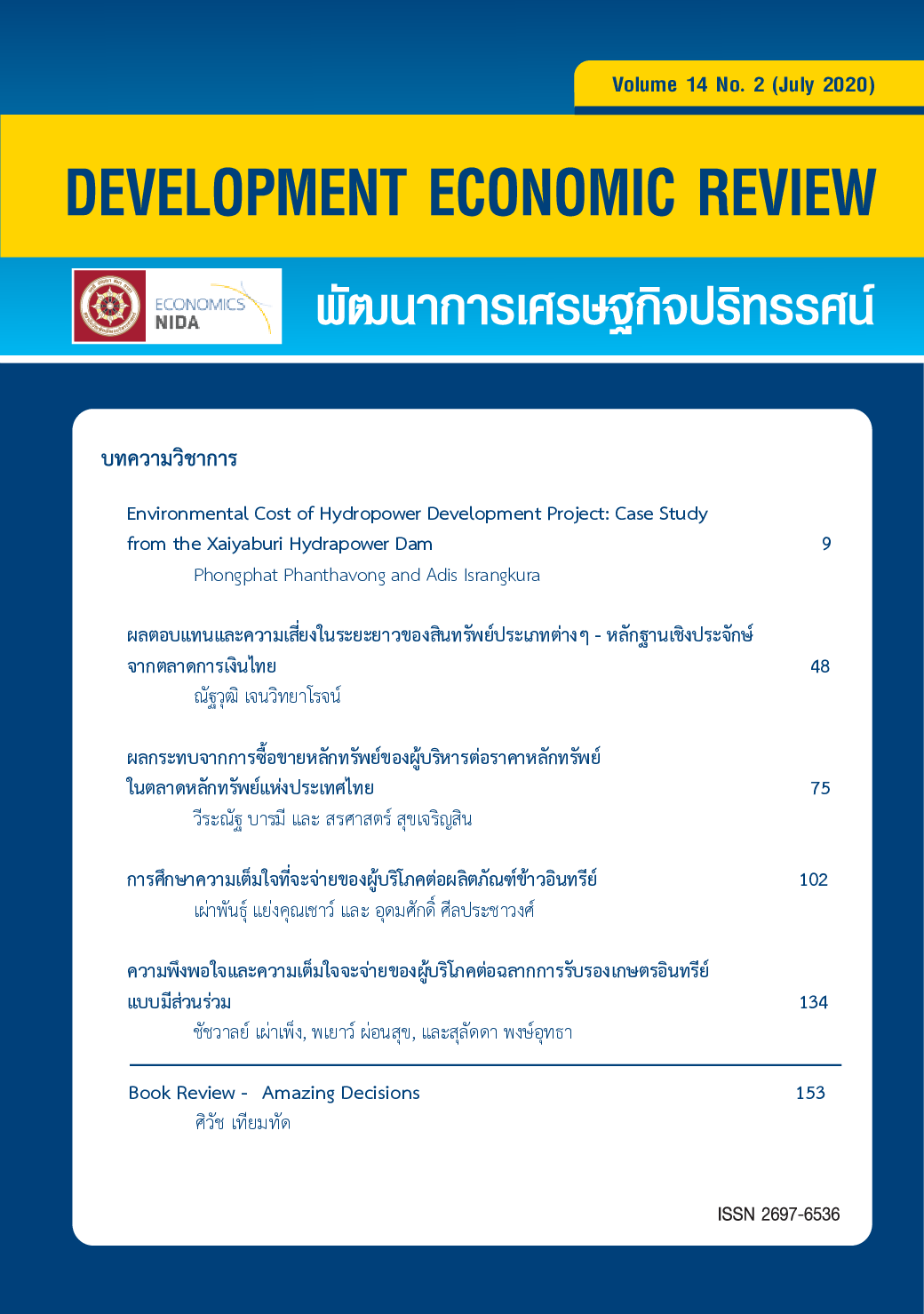The Long-Run Returns and Risks of Various Asset Classes: Evidence from Thailand’s Financial Markets
Keywords:
Return, Risk, Stock, Bonds, Gold, Inflation, Equity Risk PremiumAbstract
This study estimates the return and risk of the following four asset classes in Thailand financial markets during the period 1976-2017. The study shows that over the 42-year period, common stock gives the highest rate of total return of 12.46 percent per year, but also with high volatility, measured by yearly returns of 42.62 percent per year. Ten-year government bonds (proxies for long-term government bonds), gold, and one-year government bills (which proxies for short-term government bonds) give rate of total returns of 7.70 percent, 6.63 percent, and 6.58 percent per year, respectively. One-year government bills and ten-year government bonds have a very low volatility of only 3.55 percent to 4.14 percent per year. But gold is quite volatile with a standard deviation of returns of 24.79 percent per year. However, the real returns (i.e., adjusted for inflation) of common stocks, ten-year government bonds, one-year government bills, and gold are all positive at 7.55 percent, 3.51 percent, 2.40 percent and 2.28 percent per year, respectively. Therefore, it can be concluded that all four main asset classes in Thailand can act as inflation-hedging instruments very well during the period.
References
Benartzi, S., & Thaler, R. H. (1995). Myopic loss aversion and the equity premium puzzle. The Quarterly Journal of Economics, 110(1), 73-92.
Blose, L. E. (2010). Gold prices, cost of carry, and expected inflation. Journal of Economics and Business, 62(1), 35-47.
Damodaran, A. (2018). Equity Risk Premiums (ERP): Determinants, Estimation and Implications – The 2018 Edition. Retrieved from https://papers.ssrn.com/sol3/papers.cfm?abstract_id=3140837.
Dimson, E., Marsh, P., & Staunton, M. (2017). Credit Suisse Global Investment Returns Yearbook 2017, Zurich: Credit Suisse Research Institute. Retrieved from https://realestateforums.net/uploads/default/original/2X/6/6f507e741488a2f154402274203eaff68330d40f.pdf.
Donadelli, M., & Prosperi, L. (2011). The Equity Risk Premium: Empirical Evidence from Emerging Markets, Working Paper, Retrieved from http://ssrn.com/abstract=1893378.
Hillier, D., Draper, P., & Faff, R. (2006). Do precious metals shine? An investment perspective. Financial Analysts Journal 62(2), 98–106.
Mehra, R., & Prescott, E. C. (2014). The equity premium: A puzzle. Journal of Monetary Economics, 15(2), 145-161.
Mehra, R. (2003), The equity premium puzzle: Why is it a puzzle? (corrected). Financial Analysts Journal, 59(1), 54-69.
Salomons, R. & Grootveld, H. (2003). The equity risk premium: Emerging vs Developed Markets. Emerging Markets Review, 4(2), 121-144.
Sharma, S. (2016). Can consumer price index predict gold price returns?. Economic Modelling, 55(C), 269-278.
Siegel, J. J. (1998). Stocks for the Long Run. 3rd edition. New York. McGraw-Hill.
Siegel, J. J. (2005). Perspectives on the Equity Risk Premium, Financial Analysts Journal, 61(6), 61-73.
Tkacz, G. (2007). Gold prices and inflation, Bank of Canada Working Paper 2007-35. Retrieved from https://www.bankofcanada.ca/wp-content/uploads/2010/02/wp07-35.pdf.
Worthington, A. C., & Pahlavani, M., (2007). Gold investment as an inflationary hedge: cointegration evidence with allowance for endogenous structural breaks. Applied Financial Economics Letter, 3, 259–262.
Downloads
Published
Issue
Section
License
Copyright to published manuscripts becomes the property of the Graduate School of Development Economics, National Institute of Development Administration. Reproduction of all or part of a Development Economic Review (DER) article by anyone, excluding author(s), is prohibited, unless receiving our permission.
Disclaimer: Opinions expressed in articles published in this journal are those of the author (s) and do nto necessarily represent opinions of the Graduate School of Development Economics, National Institute of Development Administration. Trade and proprietary names are only for identification and not constitute our endorsement.


